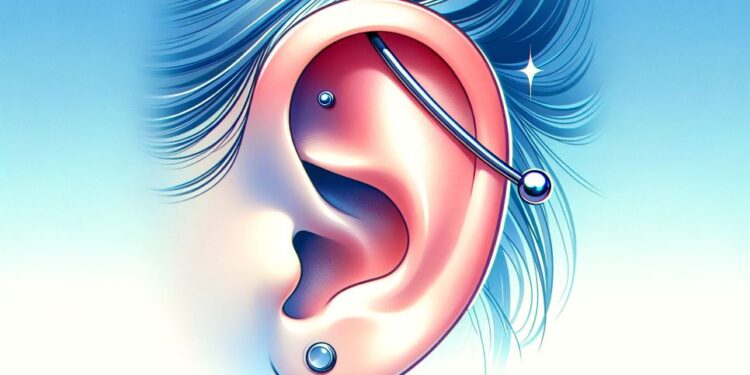Introduction to Helix Piercing
Helix piercing has become a prominent form of self-expression, offering an edgy yet sophisticated twist on traditional earlobe piercings. Located along the upper cartilage of the ear, the helix piercing stands out for its versatility and potential for customization. However, its placement in the cartilage also requires more care and attention during the healing process than a standard earlobe piercing. The importance of proper aftercare cannot be overstated, as it ensures a smooth healing process, minimizing the risk of infection and other complications. In this comprehensive guide, we will delve into the step-by-step care routine for your helix piercing, ensuring that your new adornment heals beautifully and remains a healthy and stylish addition to your look.
Initial Aftercare: The First 48 Hours
The first 48 hours after receiving a helix piercing are critical. During this time, your piercing is the most vulnerable to bacteria and trauma. It’s imperative to avoid touching the pierced area with unwashed hands. Begin your aftercare routine by cleaning the area twice daily with a saline solution or a specialized piercing aftercare product recommended by your piercer. To do this, soak a clean gauze or cotton pad in the solution and gently press it against your helix piercing for a few minutes to soften any formed crust. Rotate the jewelry slightly to ensure the solution reaches the inside of the piercing channel. Avoid using alcohol or hydrogen peroxide, as they can be too harsh and delay the healing process.
The Healing Process: Weeks and Months Following
The healing time for a helix piercing can vary from person to person, typically taking anywhere from 3 to 6 months. During this period, your aftercare routine must be maintained consistently. Even if the piercing seems healed on the outside, the internal tissue may still be delicate. Resist the urge to change your jewelry prematurely, which can introduce bacteria or cause unnecessary irritation. Maintain a gentle cleaning routine, gradually reducing the frequency as the piercing heals. Sleeping on the pierced ear can cause pressure and irritation, so it’s advisable to sleep on your back or opposite side if possible. Additionally, ensure your bed linens are clean to avoid exposing your piercing to additional bacteria.
Recognizing and Addressing Complications
Complications such as infections, keloids, or piercing bumps can occur, but prompt action can usually mitigate these issues. Signs of infection include persistent redness, swelling, throbbing pain, and yellow or green discharge. If you suspect an infection, continue cleaning the area, but consult a healthcare professional for advice – they may prescribe a topical antibiotic or suggest further treatment. Keloids and piercing bumps are scar tissue that form due to irritation. To reduce their occurrence, avoid playing with your jewelry and ensure you’re not allergic to the material. If a bump does appear, continue your aftercare routine, but seek advice from your piercer for specialized treatments that can help.
Jewelry Considerations and Long-Term Care
The type of jewelry you choose for your helix piercing can have a significant impact on the healing process. Initially, piercers typically use longer barbells or hoops to accommodate any swelling. Once healed, you can switch to more snug-fitting options. Opt for high-quality materials such as surgical stainless steel, titanium, or gold to avoid allergic reactions and facilitate healing. Even after your helix piercing has healed, you should maintain good hygiene habits. Clean your piercing site and jewelry regularly to prevent the build-up of oils, dead skin, and products. It is also the perfect time to ensure your jewelry is secure to avoid unexpected losses.
Lifestyle Adjustments for Optimal Healing
Your daily habits can influence the healing of your helix piercing. Activities such as talking on the phone, wearing over-ear headphones, or participating in sports may need to be adjusted to reduce the risk of irritation. Opt for using the speaker function on your phone or in-ear headphones, and when engaging in physical activities, consider covering your piercing with a clean, breathable material to protect it from impact and sweat. Remember that excessive sweat and friction can irritate your piercing, so always clean the area after exercising or significant sweating.
Professional Check-ups and When to Seek Help
It’s a wise practice to return to your piercer for a check-up after a few weeks, especially if you have any concerns. They can assess the healing process and address any issues that may arise. If at any point you experience severe pain, excessive swelling, or signs of an allergic reaction, it’s essential to seek professional help immediately. Piercers and dermatologists can provide guidance and, if necessary, medical treatment to ensure the health of your piercing.
Conclusion
Caring for a helix piercing is a commitment that requires patience and diligence. Following a strict aftercare routine and being mindful of potential complications will ensure that your piercing heals properly. Remember that each individual’s body is different, and healing times can vary. Treat your piercing carefully, and it will soon become a seamless part of your style. With the proper maintenance and attention, your helix piercing will be a beautiful, healthy addition you can enjoy for years.
Also, Read QC Shoes-Elevating Every Step with Innovative Comfort.



















